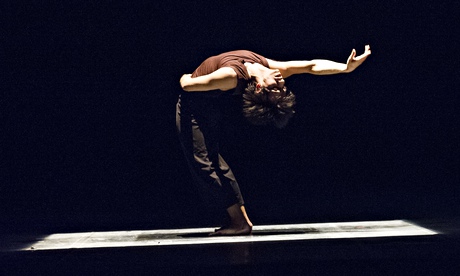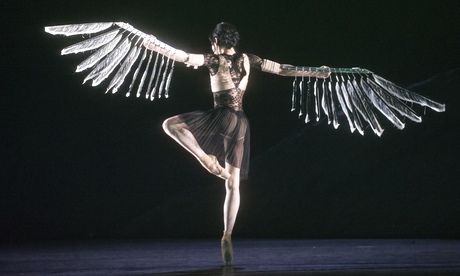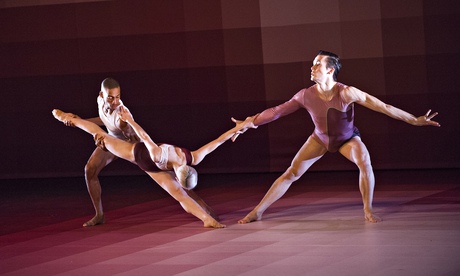Lucy Carter has strong feelings about the power and possibilities of light. "It affects everything," she says. "You can be feeling quite awful somewhere, and it's simply because the lighting is so terrible. It's very emotive." To make her point, Carter indicates the subtle changes of light taking place in and around the boxy little office at the Trinity Laban dance centre in London, where we are talking. "I'm wondering whether this is natural light coming through the window," she says, "or internal light. And why the grass outside looked so vibrantly green a while ago – but now looks sort of muddy."
As a lighting designer, Carter admits that she is constantly processing this kind of information. It all began when she was a dance student, and found herself becoming more interested in lighting pieces than choreographing them. And in the last 20 years, it's taken her to the forefront of a whole generation of designers who've taught dance audiences to see light in new ways. Carter, along with Michael Hulls,Guy Hoare and others, have made light do way more than simply make performers visible. They've made it a form of choreography in its own right.
Watching the work of Wayne McGregor, with whom Carter regularly collaborates, it's sometimes impossible to separate the movement from the light: the mysteriously glowing halos that enclosed the dancers in 2012's Carbon Life; or the pixelated colouring in 2013's Atomos that took its cast through smog and fire into suspended celestial space.
The same is true of Hulls's many collaborations with Russell Maliphant. In 2009's AfterLight, the spinning momentum of the solo dancer became almost indistinguishable from the spiralling pattern of light whirling around him – first concentrating, then diffusing, the dervish ferocity of his turns. It's far more than courtesy that makes Maliphant cite Hulls as a co-creator. As the designer explains: "People have always assumed that lighting can be like a layer, applied over the finished work – that the designer can be brought in at the last moment. But we begin from day one."
 Daniel Proietto in 2x2 by Maliphant from Men in Motion by Ivan Putrov at London Coliseum. Photograph: Tristram Kenton for the Guardian
Daniel Proietto in 2x2 by Maliphant from Men in Motion by Ivan Putrov at London Coliseum. Photograph: Tristram Kenton for the GuardianMaliphant and Hulls met in 1994, finding they shared an interest in "what a real collaboration between dance and light would look like, where each would totally affect what the other does". Fittingly, their most famous collaboration is called Two: a duet for dance and light in which the solo performer's body is both sculpted by light into something mysterious and dense, and then, by a reverse process, dissolved into radiance and air.
It's an astounding alchemy – yet it was discovered purely by accident, as the two men experimented on stage one day. Hulls was playing with the idea of having "two long strips of light just over a metre apart, like railroad tracks". They asked their guinea pig, dancer Dana Fouras, to perform a range of movements between the lines. One was a series offast "chaine" turns with whipping arms, and the result, recalls Hull, "was something we'd never seen before". As Fouras moved between darkness and light, "her arms began flashing and creating this flaring effect. It was amazing."
For Carter and McGregor, the dialogue between light and choreography is no less involved, although it begins in a more abstract way. At the start of any new project, the two discuss the conceptual or narrative ideas McGregor has. Then Carter will go off on her own, developing lighting ideas that might evolve with the choreography. It helps that Carter has a clear idea of what McGregor needs, having lit all but one of his productions. "Lucy refines and finesses lighting to such a degree," he says, "that it grows and changes with the choreography. If I make a cloud structure, she can give me some kind of cloudiness in the lights. In one section of Atomos, I made origami structures and Lucy produced this sense of folding light that was really beautiful."
Paradoxically, the evanescent poetics of light often depend on technology of blinding complexity. "I used to sketch everything out on paper," says Carter. "But now it's all done on computer. Even the lights have become intelligent. They can do more than one thing now. Some can even solve their own problems." She cites the LED lights she used recently that are capable of blending colour in response to video footage. She laughs and admits: "I wasn't at all good at maths and science at school." Still, she only engages with new technology when she must. "Only when I have an idea and don't know how to make it happen."
 A scene from Raven Girl by Wayne McGregor and the Royal Ballet at the Royal Opera House in London Photograph: Tristram Kenton for the Guardian
A scene from Raven Girl by Wayne McGregor and the Royal Ballet at the Royal Opera House in London Photograph: Tristram Kenton for the GuardianHulls's instincts have remained more low-tech: he still prefers working things out with pencil and paper. But he will research new tools when required. With AfterLight, he couldn't get the effect he wanted from a conventional lighting rig, so, with the help of animator Jan Urbanowski, he created a swirl of digital patterned light that was projected over the dancer. "It was like seeing a cyclone on a weather satellite," he says. "The light was very textured and organic – it could move, dissolve and reform."
Such poetic innovations do, of course, take time – but sometimes time isn't available. When Carter made Atomos with McGregor, she had two weeks to experiment with the rig and dancers before the premiere. But McGregor is also resident choreographer of the Royal Ballet and, when they work together at the Opera House, time can be even tighter.Tetractys: The Art of Fugue, their new one-act ballet premiering this week, is the result of three three-hour sessions on the stage.
"You tear your hair out," says Carter, "because you just have to throw stuff at the stage and see what sticks. You can't craft it or change it." But for all the frustrations she encounters, Carter is happy that she and her peers are gaining recognition. Once, lighting designers were rarely mentioned in reviews, and certainly never known to the public. In the 2010 Olivier awards, however, Hulls was nominated for outstanding contribution to dance, a category dominated by performers and choreographers. And the industry now has its own major awards: the Knights of Illumination, set up in 2008.
To leading designer Peter Mumford, who started out in 1969, it's nothing less than a sea change. "I really think dance has led the way in exploring and expanding what light can do on stage," he says. Hulls agrees. "Light enjoys a freedom in dance, especially non-narrative dance, that it can't have in opera or theatre." In fact, Hull believes dance and light enjoy a special kinship, thanks to their shared ability to dramatise space and convey nuances of emotion. "They're both so hard to talk about," he says, "so ephemeral. They don't exist except at the moment of performance. That's why I only work in dance. It's where light can reach its full potential."

You need to be a member of National Theatre Wales Community to add comments!
Join National Theatre Wales Community